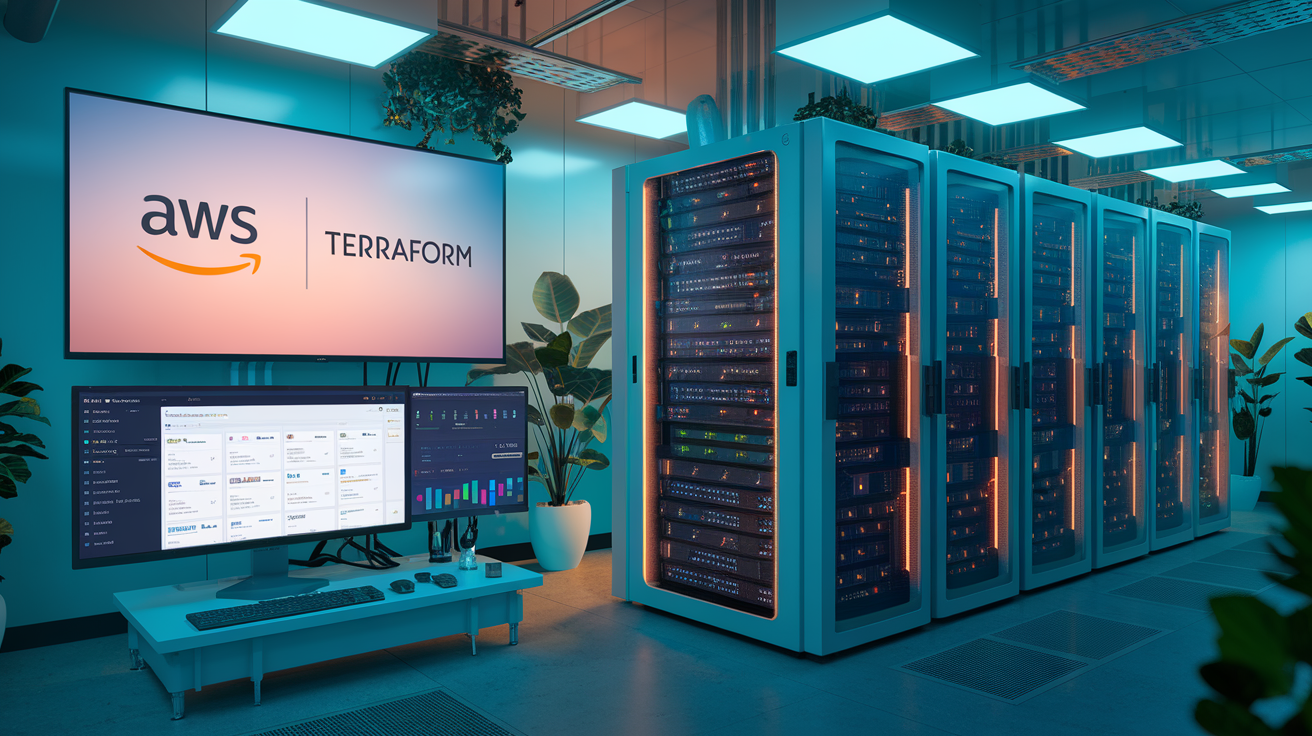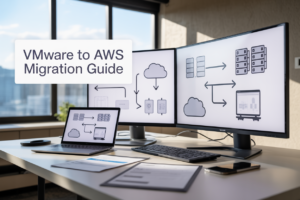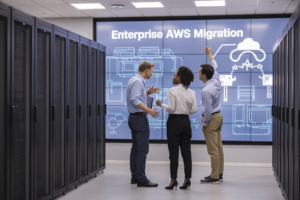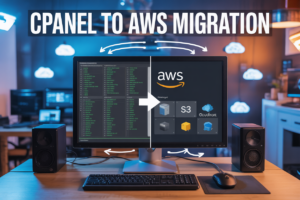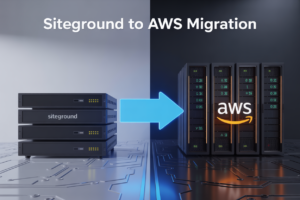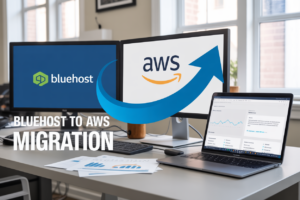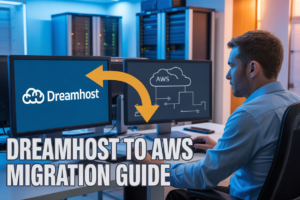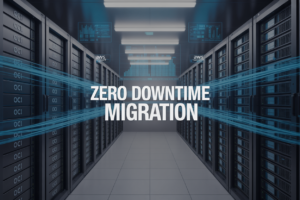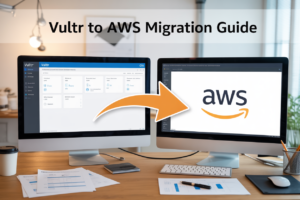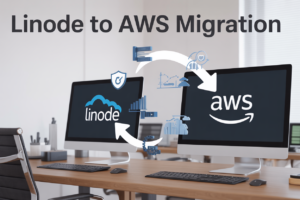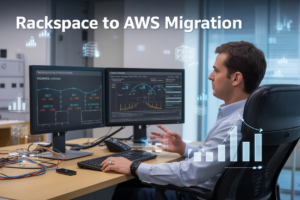Building a robust, scalable web application on AWS doesn’t have to be complicated when you combine the power of AWS three-tier architecture with Terraform infrastructure as code. This guide walks you through creating a production-ready three-tier application deployment that separates your presentation, business logic, and data layers for maximum flexibility and security.
This tutorial is perfect for DevOps engineers, cloud architects, and developers who want to automate their AWS web application architecture using modern infrastructure practices. You’ll learn how to replace manual console clicking with repeatable, version-controlled deployments that your entire team can understand and maintain.
We’ll cover the essential building blocks of AWS multi-tier architecture design, starting with how each tier works together and which AWS services power your infrastructure. You’ll also master Terraform AWS infrastructure management, from writing your first configuration files to deploying complete environments with a single command. Finally, we’ll dive deep into AWS security best practices that protect your application across all three tiers while maintaining the scalability that makes cloud infrastructure automation so powerful.
By the end, you’ll have a fully automated Terraform AWS deployment pipeline that creates secure, scalable web architecture AWS environments on demand.
Understanding Three-Tier Architecture Components and Benefits
Web Tier Design Principles for Optimal User Experience
The web tier serves as your application’s front door, handling all user interactions and HTTP requests. Design this layer with load balancers distributing traffic across multiple availability zones, ensuring high availability even during peak loads. Auto Scaling Groups automatically adjust server capacity based on demand, while CloudFront CDN delivers static content globally with reduced latency. Security groups act as virtual firewalls, controlling inbound and outbound traffic to protect your web servers from unauthorized access.
Application Tier Configuration for Scalable Business Logic
Your application tier processes business logic while remaining completely isolated from direct internet access. Deploy application servers in private subnets, communicating with the web tier through internal load balancers. This AWS multi-tier architecture design allows independent scaling of business logic components without affecting user-facing services. Implement container orchestration with ECS or EKS for microservices architecture, enabling rapid deployment and horizontal scaling. API Gateway manages service communication, providing authentication, throttling, and monitoring capabilities for your scalable web architecture AWS deployment.
Database Tier Security and Performance Optimization
Database security requires multiple layers of protection in your AWS three-tier architecture. Place databases in private subnets with no internet gateway access, using VPC endpoints for AWS service communication. Enable encryption at rest and in transit, implement automated backups, and configure Multi-AZ deployments for high availability. RDS read replicas distribute query loads, while connection pooling optimizes database performance. Database parameter groups fine-tune performance settings, and CloudWatch monitors key metrics like CPU utilization, connection counts, and query performance for proactive optimization.
Cost Efficiency Through Proper Tier Separation
Proper tier separation in your Terraform AWS infrastructure delivers significant cost savings through independent resource scaling. Web tier auto-scaling prevents over-provisioning during low traffic periods, while reserved instances reduce long-term compute costs. Application tier containerization maximizes resource utilization, and database tier right-sizing based on actual workload patterns eliminates waste. This three-tier application deployment strategy allows you to optimize each layer’s resources independently, resulting in 30-40% cost reduction compared to monolithic architectures while maintaining performance and scalability.
Essential AWS Services for Three-Tier Implementation
EC2 Instances for Compute Resources Across All Tiers
Amazon EC2 forms the backbone of your three-tier architecture, providing scalable compute power across web, application, and database tiers. Web servers handle HTTP requests, application servers process business logic, while database instances can run on EC2 when you need custom configurations beyond managed services. Choose instance types based on workload requirements – t3.medium for web servers, c5.large for CPU-intensive applications, or r5.xlarge for memory-heavy database operations. Auto Scaling Groups automatically adjust capacity based on demand, ensuring optimal performance during traffic spikes while controlling costs during low usage periods.
RDS Database Solutions for Reliable Data Management
Amazon RDS eliminates database administration overhead by providing fully managed MySQL, PostgreSQL, Oracle, or SQL Server instances with built-in backup, patching, and monitoring capabilities. Multi-AZ deployments ensure high availability through automatic failover, while read replicas distribute read traffic and improve performance. RDS integrates seamlessly with your Terraform AWS infrastructure, allowing you to define database configurations as code. Security groups restrict access to application tier instances only, while encryption at rest and in transit protects sensitive data throughout your AWS three-tier architecture.
Load Balancers for High Availability and Traffic Distribution
Application Load Balancers (ALB) intelligently distribute incoming traffic across multiple EC2 instances, preventing single points of failure in your web tier. Health checks automatically remove unhealthy instances from rotation, maintaining application availability even during server failures. Target groups organize instances by function, enabling sophisticated routing rules based on URL paths or headers. Network Load Balancers handle ultra-high performance scenarios requiring millions of requests per second. Both integrate with Auto Scaling to register new instances automatically, creating a self-healing infrastructure that scales with demand.
VPC Networking for Secure Inter-Tier Communication
Virtual Private Cloud creates isolated network environments where your three-tier application deployment operates securely within AWS. Public subnets host web servers accessible from the internet, while private subnets protect application and database tiers from direct external access. Route tables control traffic flow between tiers, and NAT Gateways enable outbound internet connectivity for private instances needing software updates. Security groups act as virtual firewalls, permitting only necessary communication between tiers. This network segmentation follows security best practices by implementing defense in depth across your scalable web architecture AWS design.
S3 Storage Integration for Static Assets and Backups
Amazon S3 serves static content like images, CSS, and JavaScript files directly to users, reducing load on EC2 instances and improving response times. CloudFront CDN integration caches S3 content globally, delivering assets from edge locations closest to users. S3 also stores application backups, log files, and configuration templates used by your Terraform infrastructure as code deployments. Versioning protects against accidental deletions, while lifecycle policies automatically transition older objects to cheaper storage classes. Cross-region replication ensures disaster recovery capabilities, making S3 an essential component of your AWS multi-tier architecture design.
Terraform Fundamentals for AWS Infrastructure Management
Infrastructure as Code Benefits Over Manual Deployment
Terraform infrastructure as code eliminates the error-prone nature of manual AWS resource creation by providing consistent, repeatable deployments. Teams can version control their infrastructure configurations, track changes over time, and collaborate effectively using standard development workflows. The declarative approach means you describe your desired end state rather than the steps to achieve it, making infrastructure management predictable and scalable. When deploying AWS three-tier architecture, Terraform automatically handles resource dependencies, ensures proper creation order, and can destroy entire environments with a single command. This approach significantly reduces deployment time from hours to minutes while maintaining accuracy across development, staging, and production environments.
Terraform State Management for Team Collaboration
Terraform state files contain critical information about your deployed AWS infrastructure, mapping real-world resources to your configuration files. Remote state backends like S3 with DynamoDB locking prevent multiple team members from making conflicting changes simultaneously. State locking ensures only one person can modify infrastructure at a time, preventing corruption and maintaining consistency across your AWS three-tier architecture deployment. The state file tracks resource metadata, dependencies, and current configurations, enabling Terraform to calculate exactly what changes need to be made during updates. Proper state management becomes essential when multiple developers work on the same Terraform AWS infrastructure, ensuring everyone sees the same infrastructure state.
Provider Configuration for AWS Resource Access
The AWS provider configuration establishes authentication and regional settings for Terraform AWS deployment operations. You can authenticate using IAM roles, access keys, or AWS CLI profiles, with IAM roles being the recommended approach for production environments. Regional configuration determines where your three-tier application deployment resources will be created, affecting latency, compliance, and disaster recovery strategies. Provider versions should be pinned to prevent unexpected changes during infrastructure updates, ensuring your AWS multi-tier architecture design remains stable. Advanced provider configurations include assume role settings for cross-account deployments, default tags for resource organization, and retry configurations for handling API rate limits during large infrastructure deployments.
Building the Web Tier Infrastructure with Terraform
Auto Scaling Groups for Dynamic Traffic Handling
Auto Scaling Groups form the backbone of your web tier’s elasticity, automatically adjusting EC2 instances based on demand patterns. Configure launch templates with your web server AMIs, define minimum and maximum capacity thresholds, and set scaling policies triggered by CloudWatch metrics like CPU utilization or request count. Target tracking policies work exceptionally well for web applications, maintaining optimal performance while controlling costs. Place instances across multiple Availability Zones for high availability, and integrate health checks to replace unhealthy instances automatically. The scaling process typically takes 3-5 minutes, so configure predictive scaling for anticipated traffic spikes during peak business hours or promotional events.
Application Load Balancer Configuration for Request Routing
Application Load Balancers distribute incoming requests across multiple EC2 instances while providing advanced routing capabilities based on URL paths, HTTP headers, or host-based rules. Configure target groups that define health check parameters and routing algorithms, with round-robin being the default distribution method. Enable sticky sessions when your application requires session affinity, though stateless applications perform better with load balancing. Set up multiple listeners for HTTP and HTTPS traffic, ensuring SSL termination at the load balancer level to reduce computational overhead on your web servers. Configure custom error pages and implement connection draining for graceful instance replacement during scaling events or maintenance windows.
Security Groups for Controlled Access Management
Security groups act as virtual firewalls controlling inbound and outbound traffic to your web tier instances. Create dedicated security groups for each component: one for the load balancer allowing HTTP/HTTPS from anywhere, and another for web servers accepting traffic only from the load balancer security group. This layered approach prevents direct access to your instances while maintaining necessary connectivity. Define specific port ranges, protocols, and source/destination rules using the principle of least privilege. Regularly audit security group rules and remove unnecessary permissions. Consider using security group references instead of IP addresses for internal communication, as this approach scales better and adapts automatically to infrastructure changes without manual intervention.
CloudFront CDN Integration for Global Content Delivery
CloudFront accelerates content delivery by caching static assets at edge locations worldwide, reducing latency and offloading traffic from your web servers. Configure distributions with your Application Load Balancer as the origin, and define caching behaviors for different content types like images, CSS, and JavaScript files. Set appropriate TTL values: longer for static assets (24 hours) and shorter for dynamic content (5 minutes). Enable compression to reduce bandwidth costs and improve load times. Configure custom error pages and origin failover for enhanced reliability. Use Lambda@Edge functions for request/response manipulation at edge locations, enabling personalization without impacting origin server performance. Monitor CloudFront metrics through CloudWatch dashboards for cache hit ratios and geographic traffic patterns.
Implementing the Application Tier for Business Logic Processing
Private Subnet Deployment for Enhanced Security
The application tier operates within private subnets across multiple availability zones, ensuring complete isolation from direct internet access. This Terraform AWS infrastructure design places application servers behind secure network boundaries while maintaining connectivity through NAT gateways. Private subnet deployment creates a protective barrier that shields business logic processing from external threats while enabling controlled outbound communication for necessary updates and API calls.
resource "aws_subnet" "app_private" {
count = length(var.availability_zones)
vpc_id = aws_vpc.main.id
cidr_block = var.app_subnet_cidrs[count.index]
availability_zone = var.availability_zones[count.index]
tags = {
Name = "app-private-subnet-${count.index + 1}"
Tier = "Application"
}
}
Network Load Balancer Setup for Internal Communication
Internal Network Load Balancers distribute traffic between the web and application tiers without exposing application servers to public networks. This AWS three-tier architecture component operates at Layer 4, providing high-performance routing with minimal latency. The load balancer health checks continuously monitor application server status, automatically removing unhealthy instances from traffic rotation while maintaining seamless user experiences.
resource "aws_lb" "app_internal" {
name = "app-internal-nlb"
internal = true
load_balancer_type = "network"
subnets = aws_subnet.app_private[*].id
enable_deletion_protection = false
tags = {
Name = "Application-Internal-NLB"
Tier = "Application"
}
}
Auto Scaling Policies for Cost-Effective Performance
Auto Scaling Groups automatically adjust application server capacity based on demand patterns, optimizing both performance and costs. Target tracking policies monitor CloudWatch metrics like CPU utilization and request count, scaling instances up during traffic spikes and down during quiet periods. This Terraform infrastructure as code approach ensures your three-tier application deployment maintains optimal performance while minimizing unnecessary compute expenses.
| Scaling Policy | Metric | Target Value | Scale Out Cooldown | Scale In Cooldown |
|---|---|---|---|---|
| CPU Utilization | Average CPU % | 70% | 300 seconds | 300 seconds |
| Request Count | Requests per target | 1000 | 300 seconds | 300 seconds |
resource "aws_autoscaling_policy" "app_scale_out" {
name = "app-scale-out"
scaling_adjustment = 2
adjustment_type = "ChangeInCapacity"
cooldown = 300
autoscaling_group_name = aws_autoscaling_group.app.name
}
IAM Roles and Policies for Service Access Control
IAM roles provide secure, temporary credentials for application servers to access AWS services without embedding long-term keys. The principle of least privilege governs policy creation, granting only specific permissions required for database connections, S3 bucket access, and CloudWatch logging. This scalable web architecture AWS security model ensures each application instance operates with minimal necessary permissions while maintaining audit trails for compliance requirements.
resource "aws_iam_role" "app_role" {
name = "app-tier-role"
assume_role_policy = jsonencode({
Version = "2012-10-17"
Statement = [
{
Action = "sts:AssumeRole"
Effect = "Allow"
Principal = {
Service = "ec2.amazonaws.com"
}
}
]
})
}
resource "aws_iam_policy" "app_policy" {
name = "app-tier-policy"
policy = jsonencode({
Version = "2012-10-17"
Statement = [
{
Effect = "Allow"
Action = [
"rds:DescribeDBInstances",
"s3:GetObject",
"logs:CreateLogStream",
"logs:PutLogEvents"
]
Resource = ["*"]
}
]
})
}
Database Tier Configuration for Reliable Data Storage
RDS Multi-AZ Deployment for High Availability
Amazon RDS Multi-AZ deployment creates a standby replica in a different availability zone, providing automatic failover capabilities for your database tier. Terraform infrastructure as code simplifies this configuration by defining RDS instances with the multi_az = true parameter. The primary database synchronously replicates data to the standby instance, ensuring zero data loss during failover events. This AWS three-tier architecture component delivers 99.95% uptime SLA and automatic patching without service interruption. Multi-AZ deployments handle hardware failures, network issues, and planned maintenance seamlessly, making your scalable web architecture AWS deployment more resilient.
Database Security Groups and Encryption Setup
Database security groups act as virtual firewalls controlling inbound and outbound traffic to your RDS instances. Configure security groups to allow connections only from application tier subnets on specific database ports like 3306 for MySQL or 5432 for PostgreSQL. Enable encryption at rest using AWS KMS keys and encryption in transit with SSL/TLS certificates. Terraform AWS infrastructure code should specify encrypted = true and define custom KMS keys for granular access control. Apply the principle of least privilege by restricting database access to necessary IP ranges and protocols only.
Backup and Recovery Strategy Implementation
RDS automated backups retain daily snapshots for up to 35 days with point-in-time recovery capabilities down to the second. Configure backup retention periods and maintenance windows through Terraform to minimize business impact. Create manual snapshots before major application updates or database schema changes. Cross-region backup replication provides additional protection against regional disasters. Set up CloudWatch alarms to monitor backup success and failure events. Your AWS security best practices should include regular backup testing and documented recovery procedures to ensure business continuity during critical incidents.
Security Best Practices Across All Architecture Tiers
Network ACLs and Security Group Rules Configuration
Network security groups act as virtual firewalls for EC2 instances, controlling inbound and outbound traffic at the instance level. Configure security groups with specific port ranges, protocols, and source/destination IP addresses to create granular access controls. Network ACLs provide subnet-level filtering, working as an additional security layer alongside security groups. Apply the principle of least privilege by allowing only necessary traffic between tiers – web tier accepting HTTP/HTTPS traffic, application tier restricted to database connections, and database tier accessible only from application servers. Use separate security groups for each tier to isolate traffic flows and prevent lateral movement between components.
IAM User and Role Management for Least Privilege Access
AWS IAM roles and policies ensure secure access to resources across your three-tier architecture deployment. Create specific roles for each tier with minimal required permissions – EC2 instances need only necessary AWS service access, database connections should use IAM database authentication where possible, and application services require targeted resource permissions. Implement cross-account roles for multi-environment deployments and use temporary credentials through AWS STS. Terraform AWS infrastructure automation benefits from service-linked roles and instance profiles that automatically rotate credentials. Regular access reviews and policy auditing help maintain security posture while enabling seamless application functionality across web, application, and database tiers.
VPC Flow Logs for Network Traffic Monitoring
VPC Flow Logs capture network traffic metadata flowing through your AWS three-tier architecture, providing visibility into communication patterns between tiers. Enable flow logs at VPC, subnet, and network interface levels to monitor traffic across web servers, application instances, and database connections. Configure log destinations to CloudWatch Logs or S3 buckets for analysis and long-term storage. Flow logs help detect unusual traffic patterns, troubleshoot connectivity issues, and support compliance requirements. Terraform infrastructure as code can automate flow log configuration across all network components, ensuring consistent monitoring coverage. Analyze source and destination IP addresses, ports, and protocols to identify potential security threats or performance bottlenecks.
AWS WAF Integration for Web Application Protection
AWS WAF protects your web tier from common attack vectors including SQL injection, cross-site scripting, and DDoS attempts. Configure WAF rules to filter malicious requests before they reach your load balancer and web servers. Create custom rules based on IP addresses, HTTP headers, request size, and geographic locations to block suspicious traffic. Rate limiting prevents abuse while allowing legitimate users access to your scalable web architecture AWS deployment. Managed rule sets from AWS and third-party providers offer pre-configured protection against OWASP Top 10 vulnerabilities. Terraform AWS deployment scripts can automate WAF rule creation and association with Application Load Balancers, ensuring consistent security policies across development and production environments.
Deployment Automation and Infrastructure Monitoring
Terraform Plan and Apply Workflows for Safe Deployment
Terraform’s two-phase deployment process protects your AWS three-tier architecture from costly mistakes. Running terraform plan creates a detailed preview of infrastructure changes, showing exactly what resources will be created, modified, or destroyed before any actual deployment occurs. This preview step catches configuration errors and helps teams review changes collaboratively through version control systems.
The terraform apply command executes the planned changes with built-in safeguards. Terraform’s state locking prevents concurrent modifications while resource dependencies ensure proper creation order across your web, application, and database tiers. Remote state storage in S3 with DynamoDB locking enables team collaboration and maintains infrastructure consistency across environments.
Implementing approval workflows through CI/CD pipelines adds another safety layer. Automated testing validates Terraform configurations before human approval, while environment-specific variable files ensure consistent deployments. Rolling back problematic changes becomes straightforward with Terraform’s state management capabilities.
CloudWatch Metrics and Alarms for Performance Tracking
CloudWatch transforms raw AWS metrics into actionable insights for your three-tier application. CPU utilization, memory consumption, and network throughput across EC2 instances reveal performance bottlenecks before they impact users. Database metrics like connection counts and query execution times help optimize RDS performance while load balancer metrics track request distribution patterns.
Custom alarms trigger automated responses when thresholds are breached. Auto Scaling groups can launch additional web servers during traffic spikes, while SNS notifications alert administrators to database connection issues. CloudWatch Logs aggregates application logs from all tiers, enabling centralized troubleshooting and performance analysis.
Dashboard creation consolidates key metrics into visual displays that stakeholders can easily understand. Real-time monitoring combined with historical trending helps capacity planning and cost optimization decisions across your Terraform AWS infrastructure.
Automated Backup and Disaster Recovery Testing
Automated RDS snapshots create point-in-time recovery options for your database tier without manual intervention. Cross-region replication ensures data survival during regional outages while automated testing validates backup integrity. Lambda functions can orchestrate complex backup workflows that include application data and configuration files.
Infrastructure as code with Terraform enables complete environment recreation from source control. Disaster recovery testing becomes routine when you can spin up entire architectures in different regions with simple commands. Automated testing scripts verify application functionality after recovery, ensuring your three-tier application deployment meets recovery time objectives.
Regular disaster recovery drills using Terraform automation build confidence in your recovery procedures. Version-controlled infrastructure definitions guarantee consistency between production and disaster recovery environments, eliminating configuration drift that could complicate emergency recoveries.
Building a three-tier AWS architecture with Terraform gives you a rock-solid foundation for scalable applications. You’ve learned how to separate your web, application, and database layers, making your system more manageable and secure. The automation power of Terraform means you can spin up identical environments in minutes, not hours, while AWS services handle the heavy lifting of infrastructure management.
Start small with a basic setup and gradually add complexity as your needs grow. Remember to bake security into every layer from day one – it’s much easier than retrofitting later. With proper monitoring in place, you’ll spot issues before they become problems. Take the plunge and begin experimenting with Terraform modules for your next AWS project. Your future self will thank you for the time saved and headaches avoided.










